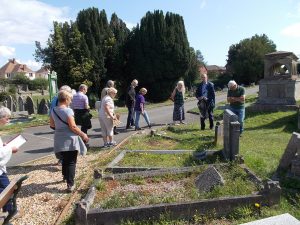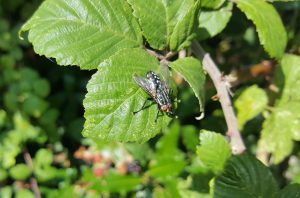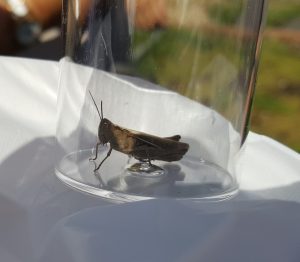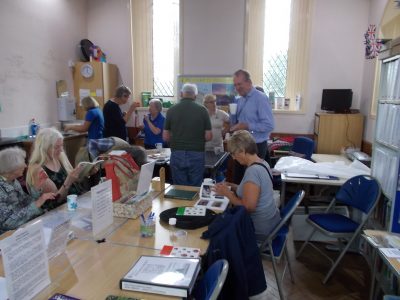An Entomology Meeting (Insect Walk) 13 August 2019
We were blessed with fine dry weather for the insect walk, led by Richard Smout. around 18 people took part. Richard explained that ‘insects’ was a vast topic and that within the various species could be hundreds of sub species; we were obviously likely to see the most common. He had brought several books to aid us.
 He led us to look around the South Chapel, before long we had seen a few bees and hover flies that are commonly mistaken for honey bees. Richard drew our attention to their body stripes, colours and wing shapes. The Red-tailed bumble bee (Bombus lapidarius) soon put in an appearance.
He led us to look around the South Chapel, before long we had seen a few bees and hover flies that are commonly mistaken for honey bees. Richard drew our attention to their body stripes, colours and wing shapes. The Red-tailed bumble bee (Bombus lapidarius) soon put in an appearance.
Richard had brought specimen pots to enable us to see close up insects that we caught (and let go again). Several were tiny including the Froghopper beetle which creates cuckoo spit to protect their larvae from predators. Grasshoppers also were caught and identified as Common Field, each variety of grasshopper and cricket have a different sound pattern. Having found a Ladybird, Richard told us something about the varieties, colours and spot variations we might see.

 We made our way around the Old Parish Cemetery, Richard swished his butterfly net among the grasses to see what might be there and emptied it out onto a white sheet, which some smaller insects were immediately attracted to. That part of the cemetery has been left as a nature conservation area in which we saw several butterfly species; Gatekeeper, Common Blue and Holly Blue, Large and Small White were in abundance. The graves were a haven for woodlice which appeared in great numbers once they were disturbed also, we saw a great number of anthills, some very large.
We made our way around the Old Parish Cemetery, Richard swished his butterfly net among the grasses to see what might be there and emptied it out onto a white sheet, which some smaller insects were immediately attracted to. That part of the cemetery has been left as a nature conservation area in which we saw several butterfly species; Gatekeeper, Common Blue and Holly Blue, Large and Small White were in abundance. The graves were a haven for woodlice which appeared in great numbers once they were disturbed also, we saw a great number of anthills, some very large.
The hour passed so quickly, then having returned to the centre for refreshments many people had questions and observations for Richard.
Photographs by Colin Hunt & Dave Bushell

